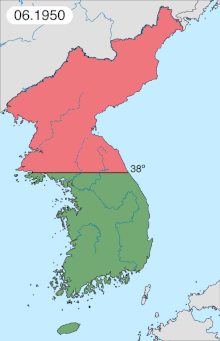Operation Glory
Operation Glory was an American effort to repatriate the remains of United Nations Command casualties from North Korea at the end of the Korean War. The Korean Armistice Agreement of July 1953 called for the repatriation of all casualties and prisoners of war, and through September and October 1954 the Graves Registration Service Command received the remains of approximately 4,000 casualties.[1][2][3][4] Of the 1,868 American remains, 848 unidentified remains were buried as "unknowns" at the National Memorial Cemetery of the Pacific in Hawaii.[5]
Some of the remains came from the temporary military cemeteries in North Korea that had been abandoned as Chinese forces pushed US forces out of North Korea.[6] Public ceremonies involving delivery of the returned remains included honor guards.[6] Also exchanged were the remains of approximately 14,000 North Korean and Chinese casualties.[7]
References
- Coleman, Bradley Lynn (January 2008). "Recovering the Korean War Dead, 1950–1958: Graves Registration, Forensic Anthropology, and Wartime Memorialization". The Journal of Military History. Project Muse (Society for Military History). 72 (1): 179–222. doi:10.1353/jmh.2008.0013. ISSN 0899-3718.
- "Operation GLORY: Historical Summary". Condensed from Graves Registration Division, Korean Communications Zone (KCOMZ). Fort Lee, VA: Army Quartermaster Museum. July–December 2004. Note: the calculation of remains comes from Coleman as the "Historical Summary" gives a total of 4,023 UN remains received.
- But see: Sherrell, Chandler (1998). A Historical Analysis of United States Prisoner of War/Missing in Action Repatriation and Remains Recovery. Fort Leavenworth, Kansas: U. S. Army Command and General Staff College. p. 38. OCLC 831669354.
During Operation GLORY, 1,879 sets of remains were returned. Of those, 1,020 were positively identified, and another 859 unidentified remains were declared unknown casualties.
- Not all remains were returned to the home countries. Some of the 2,300 remains buried at the United Nations Memorial Cemetery in Busan, South Korea were recovered during Operation Glory.
- Keene, Judith (February 2010). "Below Ground: The Treatment of American Remains from the Korean War". The Public Historian. National Council on Public History. 32 (1): 58–78. doi:10.1525/tph.2010.32.1.59. ISSN 0272-3433. JSTOR 10.1525/tph.2010.32.1.59.
- Sledge, Michael (2007) [2005]. Soldier Dead: How We Recover, Identify, Bury, and Honor Our Military Fallen. New York: Columbia University Press. pp. 78, 199. ISBN 9780231509374. OCLC 60527603.
- Cole, Paul M. (1994). "Three: Efforts to Recover and Account for Korean War Casualties". POW/MIA Issues Volume 1, The Korean War (PDF). Santa Monica, CA: National Defense Research Institute. p. 68. ISBN 9780833014825. OCLC 855303293.
Further reading
- Cannon, Florence (May–June 1952). "Our Honored Dead". The Quartermaster Review. United States Quartermaster Museum & The Memorial Day Foundation.
- Cook, James C. (March–April 1953). "Graves Registration in the Korean Conflict". The Quartermaster Review. Fort Lee, VA: Army Quartermaster Museum. Archived from the original on 2017-12-03. Retrieved 2013-11-11.
- Martz, John D. (May–June 1954). "Homeward Bound". Quartermaster Review. Fort Lee, VA: US Army Quartermaster Foundation. Archived from the original on 2013-11-02. A description of the post-recovery processing of casualties undertaken at Kokura, Japan, in which the remains were identified and prepared for repatriation.
